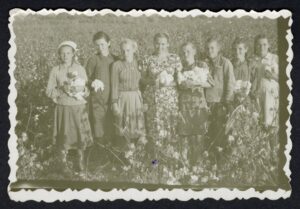
Stanisława Lisowska (second from the left) standing in the field of cotton with her friends. 1953. Sybir Memorial Museum collection
The girl in the photograph from 1953 (second from the left) is Stanisława Lisowska. She is standing in a field of cotton with her friends. The Lisowski family was from the village of Jurewicze in Grodno Oblast. In 1952, Witold Lisowski was sentenced to 7 years of detention and forfeiture of property because he had refused to deliver wood. He served his punishment in prison in Irkutsk.
In the spring of 1952, his wife Genowefa and children, Stanisława, Elwira, Łucja and Romuald, were deported to Kazakhstan, near the city Pakhta-Aral. The family was told to work growing cotton in Vladimir Lenin’s kolkhoz.
Stanisława recollected after many years: “After we were shown our accommodation, we were ordered to work in the cotton field in a kolkhoz. We worked from morning to evening, with a lunch break. Nobody worked in the afternoon because the heat was too heavy. While in Kazakhstan, I went to school, and after the classes I had to pick cotton”.
With whom is she standing in the photograph? Who shared her misery in exile?



